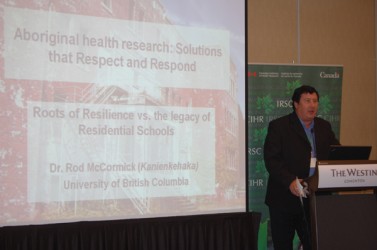Article Origin
Volume
Issue
Year
Rod McCormick delivered his presentation on Indian Residential School survivors and their resiliency in front of a picture of St. Michael’s residential school at Alert Bay, B.C. The decrepit brick building stands at the centre of the small village and is still being used.
“It dominates the village. . . . It is the big centerpiece as you come into the bay,” McCormick told a roomful of journalists and academics at a presentation Sept. 24 sponsored by the Canadian Institutes of Health Research-Institute of Aboriginal.
The building has been converted into a community centre and sits as a testament to how resilience has reshaped something that stole the way of life of many.
McCormick is a Mohawk psychologist and professor of counseling psychology at the University of B.C., as well as a former mental health consultant with the Truth and Reconciliation Commission.
There are many factors that promote resiliency and many definitions of resiliency. McCormick held that the best definition of resiliency for Aboriginal people is “relational rather than a linear worldview.
“A relational worldview takes in the mental, physical, emotional and spiritual dimensions, as well as the interconnected nature of humans.”
Under a policy of assimilation, Aboriginal children were removed from their homes beginning in the mid-1800s. St. Mary’s, in British Columbia, was the first residential school to open its doors (1861) and the last to close (1984). Disconnection was the method employed by the schools, through government and churches, with children cut off from their families, communities and cultural practices.
McCormick drew the connection between Aboriginal people and genocide. According to the 1948 United Nations Convention of the Prevention and Punishment of the Crime of Genocide, genocide is defined as “any of the following acts committed with intent to destroy, in whole or in part, a national, ethnical, racial or religious group.” Canada signed the convention.
In what McCormick referred to as “controversial slides” in his presentation, he compared the Aboriginal experience to those of Jewish concentration camps, pulling on Holocaust survivor Viktor Frankl’s logotherapy as an explanation.
“(Frankl said that) those that survived these incredibly adverse conditions had a strong reason for survival…What gave us the source of meaning was spirituality, work, significant relationships, contributing to your community, etc. I think that’s essentially what the government either intentionally or accidently came across… that if you separate people from those very sources of meaning, you have a better chance of eventually eliminating them,” said McCormick.
When most residential schools closed in the 1960s, the government of the day continued the policy of assimilation in what has become known as the “Sixties Scoop.”
Many Aboriginal children were taken from homes the government declared unfit and placed in foster care or adopted. McCormick noted that more children were apprehended in this manner than ever attended decades of residential schools.
Despite a systematic approach to destroy Aboriginal people, McCormick said there are many stories of resiliency.
“What facilitates healing in First Nations people is balance, connectedness, cleansing, empowerment and (the) spiritual,” said McCormick.
McCormick is presently involved in the Roots of Resilience project, which includes collecting stories of resilience, healing, and transformation.
“The aim of the Stories of Resilience project is to collect stories to help define resilience from Aboriginal perspectives and to identify factors that promote resilience among individuals and communities,” said McCormick.
McCormick was highly critical of Health Canada’s approach for strategic planning for Aboriginal long-term health planning and the department’s use of “mechanistic” language.
“Health Canada has been in the business of pushing. . . . We are instinctively pulled towards reason for living a good and healthy life and it’s not instinctive to be pushed. And I think when we’re pushed we tend to be resistant and that resistance can sometimes end up in self-destructive behavior,” said McCormick.
He believes that Health Canada has “to remove the barriers,” which he noted included such factors as lack of access, lack of culturally-appropriate programming, and short-term funding, and allow Aboriginal people to seek healing through traditional and cultural means.
“My message (to Health Canada) is to get out of the way, help us clear those barriers and we will go toward health,” said McCormick.
CIHR’s experts presented on a number of topics throughout the day, including reaching young people for health services, building strategies for suicide prevention, health issues for Metis and Inuit peoples, diabetes, and approaches to genetic research.
The workshop was designed to promote better understanding of and coverage by the media of health issues surrounding Aboriginal people, as well as to allow the media access to researchers in the field of Aboriginal health.
- 5851 views

